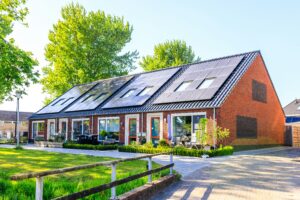Creating Energy-Efficient Homes: Key Design Principles for Sustainability


Energy efficiency has become one of the most crucial aspects of modern home design. As environmental concerns grow and energy prices continue to rise, the demand for energy-efficient homes has skyrocketed. Homeowners are increasingly seeking ways to reduce their carbon footprints and minimize their energy consumption. Building or renovating homes with energy efficiency in mind not only supports sustainability but can also provide long-term savings. Here are some key design principles that can help create energy-efficient homes.
Orientation and Passive Solar Design
The orientation of a home plays a vital role in its energy efficiency. By positioning a house to take advantage of the sun’s natural light and heat, homeowners can reduce their dependence on artificial lighting and heating. A well-oriented home utilizes passive solar design principles, which harness the sun’s energy for heating in winter and cooling in summer. Large south-facing windows allow sunlight to enter and warm the interior during colder months, while shading devices can prevent overheating in the warmer months.
Additionally, the home’s layout should promote natural airflow. The strategic placement of windows, vents, and doors can help facilitate cross-ventilation, allowing cool air to circulate through the house. This not only reduces the need for air conditioning but also improves indoor air quality. In this way, passive solar design can dramatically reduce energy consumption while enhancing comfort inside the home.
High-Performance Insulation and Air Sealing
Insulation is one of the most effective ways to improve energy efficiency. Proper insulation reduces the need for heating and cooling by creating a thermal barrier that keeps conditioned air inside the home. However, it’s essential to consider the R-value, or thermal resistance, of the materials used. The higher the R-value, the better the insulation’s performance. Walls, attics, and floors should all be insulated to prevent heat loss or gain.
In addition to insulation, air sealing is equally crucial. Even the best insulation won’t be effective if there are gaps and leaks in the home’s structure. Air leaks around windows, doors, and ducts can lead to significant energy loss. Sealing these gaps with weatherstripping or caulking can prevent drafts and ensure that the home remains comfortable year-round. Both insulation and air sealing should be prioritized in any energy-efficient home design.
Energy-Efficient Windows and Doors
Windows and doors are the primary points where energy is lost in most homes. Therefore, selecting energy-efficient windows and doors is a key design principle for sustainability. Double or triple-glazed windows are an excellent choice for reducing heat loss in winter and keeping cool air inside during summer. These windows have insulating properties that reduce the amount of heat that can escape or enter, thus maintaining a consistent indoor temperature.
Additionally, energy-efficient windows often feature low-emissivity (low-E) coatings that reflect heat into the room during the winter, while keeping excess heat out during the summer. Similarly, doors should be well-insulated and fitted with weatherstripping to minimize energy loss. Ensuring that windows and doors are correctly installed and sealed is equally essential to maintain their performance and effectiveness.
Renewable Energy Systems
One of the most impactful steps in creating an energy-efficient home is integrating renewable energy systems. Solar panels are a popular choice for homeowners looking to reduce their reliance on grid electricity. By converting sunlight into usable electricity, solar energy systems can significantly lower energy bills and even eliminate them, depending on the system’s size and the home’s energy consumption.
Another renewable energy option is wind power, especially in areas with consistent wind patterns. Wind turbines can generate electricity on-site, further reducing the home’s carbon footprint. Geothermal heating and cooling systems are also a highly efficient option for homes, utilizing the constant temperature of the earth below the surface to regulate indoor temperatures. The upfront cost of these renewable energy systems can be high, but the long-term savings and environmental benefits make them worthwhile investments.
Smart Home Technology
Incorporating smart home technology is another powerful way to enhance a home’s energy efficiency. Smart thermostats, for example, can automatically adjust the temperature based on occupancy patterns and time of day, reducing unnecessary heating and cooling. These devices can be controlled remotely, allowing homeowners to manage energy use even when they’re away from home.
Other innovative technologies, such as lighting systems that turn off when rooms are unoccupied or appliances that operate during off-peak hours, can also contribute to energy savings. In addition to reducing energy consumption, these systems enhance convenience and help homeowners track their energy use through detailed reports. As smart home technology continues to evolve, its role in enhancing energy efficiency will only continue to grow.
Sustainable Materials and Finishes
Another principle of energy-efficient home design is the use of sustainable materials. Opting for environmentally friendly materials can significantly reduce a home’s environmental impact. For instance, reclaimed wood, bamboo, and cork are renewable materials that can serve as durable options for flooring, cabinetry, and furniture. Choosing materials that are locally sourced can also help minimize the carbon footprint associated with transportation.
Additionally, finishes and paints should be selected with sustainability in mind. Low-VOC (volatile organic compounds) paints, for example, emit fewer harmful chemicals into the air and are safer for both the environment and the inhabitants. Sustainable materials not only support energy efficiency but also contribute to a healthier living environment.
Water Efficiency
Water conservation is an often-overlooked aspect of energy-efficient home design. The amount of energy required to pump, heat, and treat water can be substantial. By incorporating water-saving fixtures such as low-flow faucets, showerheads, and dual-flush toilets, homeowners can reduce both their water and energy consumption. Additionally, installing a rainwater harvesting system can provide an eco-friendly source of water for irrigation and other non-potable uses, further reducing the home’s overall environmental impact.
